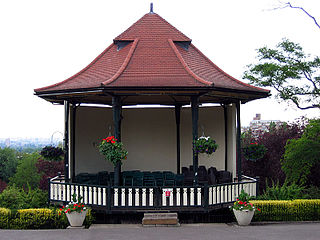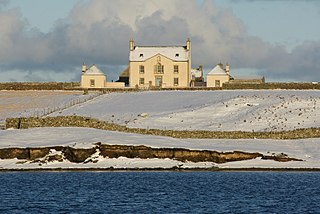
Sharon Springs is a village in Schoharie County, New York, United States. The population was 558 at the 2010 census. Its name derives from the hometown of the first Colonial settlers, Sharon, Connecticut, and the important springs in the village. Sharon Springs, Kansas likewise was settled by former residents of this Upstate New York village.

A bandstand is a circular, semicircular or polygonal structure set in a park, garden, pier, or indoor space, designed to accommodate musical bands performing concerts. A simple construction, it both creates an ornamental focal point and also serves acoustic requirements while providing shelter for the changeable weather, if outdoors. In form bandstands resemble ornamental European garden gazebos modeled on outdoor open–sided pavilions found in Asian countries from early times.

Clan Mackenzie is a Scottish clan, traditionally associated with Kintail and lands in Ross-shire in the Scottish Highlands. Traditional genealogies trace the ancestors of the Mackenzie chiefs to the 12th century. However, the earliest Mackenzie chief recorded by contemporary evidence is Alexander Mackenzie of Kintail who died some time after 1471. Traditionally, during the Wars of Scottish Independence, the Mackenzies supported Robert the Bruce, but feuded with the Earls of Ross in the latter part of the 14th century. During the 15th and 16th-centuries the Mackenzies feuded with the neighboring clans of Munro and MacDonald. In the 17th century the Mackenzie chief was made Earl of Seaforth in the peerage of Scotland. During the Scottish Civil War of the 17th century the Mackenzies largely supported the Royalists. During the Jacobite rising of 1715 the chief and clan of Mackenzie supported the Jacobite cause. However, during the Jacobite rising of 1745 the clan was divided with the chief, Kenneth Mackenzie, Lord Fortrose, supporting the British-Hanoverian Government and his relative, George Mackenzie, 3rd Earl of Cromartie, supporting the Jacobites.
Strathpeffer is a village and spa town in Ross and Cromarty, Highland, Scotland, with a population of 1,469.

Buxton Opera House is in The Square, Buxton, Derbyshire, England. It is a 902-seat opera house that hosts the annual Buxton Festival and, from 1994 to 2013, the International Gilbert and Sullivan Festival, among others, as well as pantomime at Christmas, musicals and other entertainments year-round. Hosting live performances until 1927, the theatre then was used mostly as a cinema until 1976. In 1979, it was refurbished and reopened as a venue for live performance.

Empire Exhibition, Scotland 1938 was an international exposition held at Bellahouston Park in Glasgow, from May to December 1938.

Castle Leod is the seat of the Clan Mackenzie. It is a category A listed building, and the grounds are listed in the Inventory of Gardens and Designed Landscapes of Scotland, the national listing of significant gardens. It is located near Strathpeffer in the east of Ross-shire in the Scottish Highlands.

Highland Park is a historic park in Meridian, Mississippi, United States. Home to a museum honoring Jimmie Rodgers, a Meridian native, the site was listed on the National Register of Historic Places in 1979. The park is also home to the Highland Park Dentzel Carousel and Shelter Building, a National Historic Landmark manufactured around 1896 by Gustav Dentzel of Philadelphia, Pennsylvania. The historic carousel is the only two-row stationary Dentzel menagerie still in existence.

Bridlington Spa is a dance hall, theatre and conference centre in Bridlington, East Riding of Yorkshire, England. Refurbished between 2006 and 2008 and further updated with a new branding in 2016, the venue boasts a large Art Deco ball room, Edwardian theatre, art gallery and a selection of other meeting and event spaces; all featuring outstanding views over Bridlington's South Bay.

Eden Court Theatre is a large theatre, cinema and arts venue situated in Inverness, Scotland close to the banks of the River Ness. The theatre has recently undergone a complete refurbishment and major extension, adding a second theatre, two dedicated cinema screens, two performance/dance studios, improved dressing room and green room facilities and additional office space. The theatre's restaurant and bar facilities have also been totally overhauled and improved.

Scarborough Spa is a Grade II* listed building in South Bay, Scarborough, North Yorkshire, England. It is a venue for conferences, exhibitions, entertainment, live music and events on the Yorkshire Coast. Originally built around the source of Scarborough's spa waters, it is owned and managed by Scarborough Borough Council.

Montpellier Rotunda is a Grade I listed building in Montpellier, Cheltenham, England.

Belmont House is a Georgian country house on the island of Unst, the most northerly of the Shetland Islands, Scotland. It was constructed in 1775 by Shetland landowner Thomas Mouat of Garth, and has been described as "possibly the most ambitious, least-altered classical mansion in the Northern Isles." The house was restored from a derelict state between 1996 and 2010 by the Belmont Trust. The house is now used as a self catering holiday house and venue for events. It is protected as a category A listed building, and the grounds are included on the Inventory of Gardens and Designed Landscapes in Scotland, the national listing of significant gardens.

Strathpeffer railway station was a railway station serving the town of Strathpeffer in the county of Ross and Cromarty,, Scotland. The first station was located some distance from the town, on the Dingwall and Skye Railway line, and was opened in 1870.

Tarbat House is a Category A listed building in the Highland council area of northern Scotland. A three-story stone mansion in the neoclassical style, it was built in 1787 by the Edinburgh architect James McLeran for John Mackenzie, Lord MacLeod. The house is located approximately 500m from the village of Milton near Invergordon.
The Balneario da Toxa or Grand Hotel of A Toxa is a spa-hotel located in La Toja Island, in Galicia, Spain.

Barony Hall, also known as Barony Church, is a red sandstone Victorian neo-Gothic-style building on Castle Street in Glasgow, Scotland, near Glasgow Cathedral, Glasgow Royal Infirmary and the city's oldest surviving house, Provand's Lordship. The original or Old Barony Church was built as a part of the Barony Parish in Glasgow by architect, James Adams. It opened in 1799 and served ceremonial and other congregational purposes. The replacement for the old building was designed by J. J. Burnet & J. A. Campbell and raised in 1889, and incorporated architectural artifacts from the old church and a number of other relics.
Aldourie Castle is in Scotland, situated on Strath Dore, between the southern banks of Loch Ness and the Glen leading onto Drumashie Moor. The parkland of 38.9 hectares extends northeast and southeast of the house. Lying close to the village of Aldourie, it originally consisted of a rectangular main block, with a round tower at the south-west corner. In the 1860s, William Fraser-Tytler extended the castle in all directions, including a balustraded round tower, oriel windows, scroll-sided dormers, turrets, corbels, rope-moulded stringing and gunloops. It underwent extensive restoration work between 2002 and 2010, and again in 2017, when the original walled Victorian kitchen garden and surrounding grounds were revived, with help from students from the National Trust for Scotland. The gardens and parkland are included in the Inventory of Gardens and Designed Landscapes in Scotland.

Buxton Pavilion Gardens is a Victorian landscaped public park in the spa town of Buxton in Derbyshire. The River Wye flows through the gardens, which are a Grade II* listed public park of Special Historic Interest.

Dingwall Town Hall is a municipal structure in the High Street, Dingwall, Highland, Scotland. The structure, which is now used as a museum, is a Category B listed building.

















